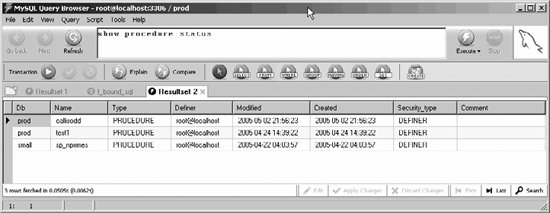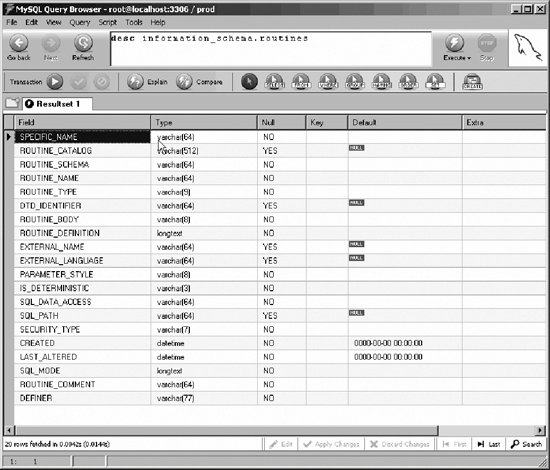Getting Information About Stored Programs
This section describes ways you can retrieve information about the stored programs that exist in your database.
In releases of MySQL prior to 5.0, extracting information about objects in the database was achieved by issuing SHOW statements. MySQL has extended the SHOW statement in version 5 to include information about stored programs.
However, in 5.0, MySQL also introduced the INFORMATION_SCHEMA database, which contains various tables that provide information about the objects that exist within the server. These tables are typically referred to as the data dictionary or as server metadata.
If you are a long-time user of the MySQL server, then using SHOW statements may seem a more natural approach to obtaining information about stored programs. However, the INFORMATION_SCHEMA tablesin addition to being ANSI standardhave the advantage of being amenable to various handy SELECT operations, such as grouping, counting, joining, and advanced filtering operations. You can also use INFORMATION_SCHEMA tables within your stored program codesomething that is not practical with SHOW statement output.
7.4.1. SHOW PROCEDURE/FUNCTION STATUS
The SHOW PROCEDURE STATUS and SHOW FUNCTION STATUS statements return information about the stored programs within the server. The syntax of this form of the SHOW statement is:
SHOW {PROCEDURE|FUNCTION} STATUS [LIKE pattern]
Figure 7-11 provides an example of SHOW PROCEDURE status output.
Figure 7-11. SHOW PROCEDURE STATUS

7.4.2. SHOW CREATE PROCEDURE/FUNCTION
The SHOW CREATE PROCEDURE and SHOW CREATE FUNCTION statements return the CREATE statement necessary to re-create a particular stored program. Figure 7-12 shows the output of this version of SHOW. Note that we used the "View Field pop-up editor" right-click option to load the text output returned by this statement into a more readable Field Viewer window.
7.4.3. INFORMATION_SCHEMA.ROUTINES Table
The INFORMATION_SCHEMA.ROUTINES table returns a variety of information about stored procedures and functions. You can use the WHERE clause and column lists within the SELECT statement to format this output in various interesting ways.
Figure 7-12. SHOW CREATE FUNCTION

This table does not contain information about triggers, but you can retrieve trigger information from the INFORMATION_SCHEMA.TRIGGERS table described in the next section.
Figure 7-13 shows the structure of the INFORMATION_SCHEMA.ROUTINES table.
You can use INFORMATION_SCHEMA.ROUTINES to return any of the data returned by the SHOW PROCEDURE STATUS, SHOW FUNCTION STATUS, SHOW CREATE PROCEDURE, and SHOW CREATE FUNCTION statements. For instance, in Figure 7-14, we produce a report that includes both the procedure/function definitions and other information about these programs.
7.4.4. INFORMATION_SCHEMA.TRIGGERS Table
The INFORMATION_SCHEMA.TRIGGERS table contains details about all of the triggers that are defined on the MySQL server. Figure 7-15 shows the output from a query against this table (using the "View Field pop-up editor" right-click option to view the contents of the action_statement column).
Figure 7-13. Structure of the INFORMATION_SCHEMA.ROUTINES table

Part I: Stored Programming Fundamentals
Introduction to MySQL Stored Programs
- Introduction to MySQL Stored Programs
- What Is a Stored Program?
- A Quick Tour
- Resources for Developers Using Stored Programs
- Some Words of Advice for Developers
- Conclusion
MySQL Stored Programming Tutorial
- MySQL Stored Programming Tutorial
- What You Will Need
- Our First Stored Procedure
- Variables
- Parameters
- Conditional Execution
- Loops
- Dealing with Errors
- Interacting with the Database
- Calling Stored Programs from Stored Programs
- Putting It All Together
- Stored Functions
- Triggers
- Calling a Stored Procedure from PHP
- Conclusion
Language Fundamentals
- Language Fundamentals
- Variables, Literals, Parameters, and Comments
- Operators
- Expressions
- Built-in Functions
- Data Types
- MySQL 5 Strict Mode
- Conclusion
Blocks, Conditional Statements, and Iterative Programming
- Blocks, Conditional Statements, and Iterative Programming
- Block Structure of Stored Programs
- Conditional Control
- Iterative Processing with Loops
- Conclusion
Using SQL in Stored Programming
- Using SQL in Stored Programming
- Using Non-SELECT SQL in Stored Programs
- Using SELECT Statements with an INTO Clause
- Creating and Using Cursors
- Using Unbounded SELECT Statements
- Performing Dynamic SQL with Prepared Statements
- Handling SQL Errors: A Preview
- Conclusion
Error Handling
- Error Handling
- Introduction to Error Handling
- Condition Handlers
- Named Conditions
- Missing SQL:2003 Features
- Putting It All Together
- Handling Stored Program Errors in the Calling Application
- Conclusion
Part II: Stored Program Construction
Creating and Maintaining Stored Programs
- Creating and Maintaining Stored Programs
- Creating Stored Programs
- Editing an Existing Stored Program
- SQL Statements for Managing Stored Programs
- Getting Information About Stored Programs
- Conclusion
Transaction Management
- Transaction Management
- Transactional Support in MySQL
- Defining a Transaction
- Working with Savepoints
- Transactions and Locks
- Transaction Design Guidelines
- Conclusion
MySQL Built-in Functions
- MySQL Built-in Functions
- String Functions
- Numeric Functions
- Date and Time Functions
- Other Functions
- Conclusion
Stored Functions
- Stored Functions
- Creating Stored Functions
- SQL Statements in Stored Functions
- Calling Stored Functions
- Using Stored Functions in SQL
- Conclusion
Triggers
Part III: Using MySQL Stored Programs in Applications
Using MySQL Stored Programs in Applications
- Using MySQL Stored Programs in Applications
- The Pros and Cons of Stored Programs in Modern Applications
- Advantages of Stored Programs
- Disadvantages of Stored Programs
- Calling Stored Programs from Application Code
- Conclusion
Using MySQL Stored Programs with PHP
- Using MySQL Stored Programs with PHP
- Options for Using MySQL with PHP
- Using PHP with the mysqli Extension
- Using MySQL with PHP Data Objects
- Conclusion
Using MySQL Stored Programs with Java
- Using MySQL Stored Programs with Java
- Review of JDBC Basics
- Using Stored Programs in JDBC
- Stored Programs and J2EE Applications
- Using Stored Procedures with Hibernate
- Using Stored Procedures with Spring
- Conclusion
Using MySQL Stored Programs with Perl
- Using MySQL Stored Programs with Perl
- Review of Perl DBD::mysql Basics
- Executing Stored Programs with DBD::mysql
- Conclusion
Using MySQL Stored Programs with Python
- Using MySQL Stored Programs with Python
- Installing the MySQLdb Extension
- MySQLdb Basics
- Using Stored Programs with MySQLdb
- A Complete Example
- Conclusion
Using MySQL Stored Programs with .NET
- Using MySQL Stored Programs with .NET
- Review of ADO.NET Basics
- Using Stored Programs in ADO.NET
- Using Stored Programs in ASP.NET
- Conclusion
Part IV: Optimizing Stored Programs
Stored Program Security
- Stored Program Security
- Permissions Required for Stored Programs
- Execution Mode Options for Stored Programs
- Stored Programs and Code Injection
- Conclusion
Tuning Stored Programs and Their SQL
- Tuning Stored Programs and Their SQL
- Why SQL Tuning Is So Important
- How MySQL Processes SQL
- SQL Tuning Statements and Practices
- About the Upcoming Examples
- Conclusion
Basic SQL Tuning
Advanced SQL Tuning
- Advanced SQL Tuning
- Tuning Subqueries
- Tuning Anti-Joins Using Subqueries
- Tuning Subqueries in the FROM Clause
- Tuning ORDER and GROUP BY
- Tuning DML (INSERT, UPDATE, DELETE)
- Conclusion
Optimizing Stored Program Code
- Optimizing Stored Program Code
- Performance Characteristics of Stored Programs
- How Fast Is the Stored Program Language?
- Reducing Network Traffic with Stored Programs
- Stored Programs as an Alternative to Expensive SQL
- Optimizing Loops
- IF and CASE Statements
- Recursion
- Cursors
- Trigger Overhead
- Conclusion
Best Practices in MySQL Stored Program Development
EAN: 2147483647
Pages: 208
